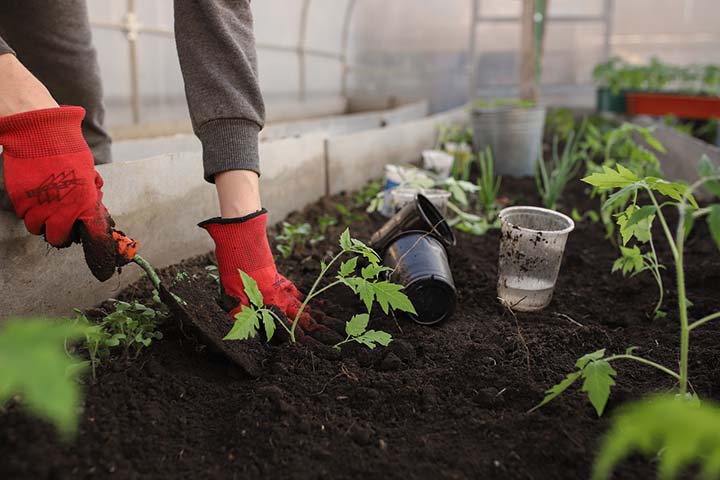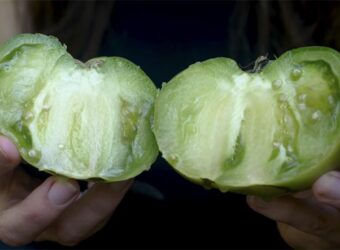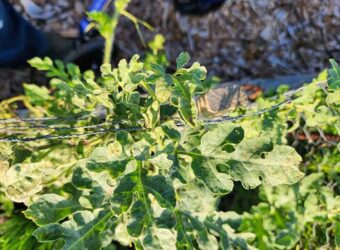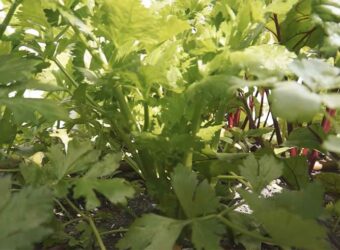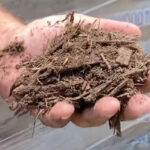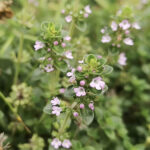Tomatoes are a very popular vegetable to grow. Home-grown tomatoes taste much better than store-bought tomatoes.
If you are going to grow tomatoes, you need to start off right by spacing the plants properly.
Why Is Spacing Important?
If you space your tomatoes properly, it will give each tomato plant the resources to grow large and have lots of tomatoes.
What Happens If You Plant Tomatoes Too Close Together?
Crowded plants are much more likely to have poor crops. Here are the things crowding does to tomato plants.
Crowded plants do not have good air circulation around them. Poor air circulation means the plants stay wet longer and are more prone to fungal and bacterial problems that need wet surfaces to attack your tomato leaves, stems, and tomatoes.
Crowded tomato plants cannot grow as big as tomato plants that have enough space. Physically, the plants grow into each other and keep each other small. In addition, tomato plants compete for water, nutrients, and sunlight. A shortage of any one of these will reduce the size of the tomato plant.
Smaller tomato plants have fewer tomatoes. Those tomatoes tend to be smaller because the plant is smaller and also because the plant doesn’t have enough resources to grow lots of large tomatoes.
Crowded plants suffer more stress. Stressed plants are more vulnerable to diseases and pests. Pests can easily move from one tomato plant to another when the plants are touching. Diseases can often attack plants that are weaker and can move from plant to plant easier when they are touching.
Tomato Plant Spacing By Garden Type
Here is how to space your tomato plants for maximum crops by the place you are planting them.
In-Ground
Tomato plants should be spaced two to three feet apart. Tomato row spacing should be three feet apart.
Raised Beds
Tomatoes for most raised beds should be spaced the same as tomatoes grown in-ground; two to three feet between plants in a row and rows three feet apart.
Square Foot Gardening
Square foot gardening is a type of intensive gardening where the garden area is divided into one-foot squares. Plants are put in each square depending on the size of the plant. Tomato plants take up four squares. Plant the tomato plant in the center, where the corners of the squares meet.
In Pots
Most tomatoes grow too large for containers. Plant compact bush-type tomatoes in 14–20-inch pots. The larger the pot, within reason, the larger the plant will grow. A five-gallon bucket with drainage holes drilled into it will make an excellent tomato pot. Place one tomato plant per pot. A cherry tomato hybrid called ‘Tumbler” will grow well in a hanging basket, and the stems will hang down attractively. Patio choice yellow hybrid has lots of yellow cherry tomatoes and grows well in a pot. Bush early girls hybrid produces beefsteak-type tomatoes about four inches in diameter in a pot.
On Trellises
You can trellis tomato plants around a single support or use a weave-type trellis. Regardless of the trellis, tomato plants still need to be two to three feet apart, and the rows need to be three feet apart. Make sure any trellis can support the weight of a mature tomato plant loaded with tomatoes. Bamboo stakes are not likely to work. Use tall enough trellises, too, as indeterminate tomato plants continue to grow all season and can get quite tall.
In Cages
It is best to use cages that are eighteen inches in diameter for each tomato plant. Any larger, and you can’t reach all the tomatoes in the cage. Indeterminate tomatoes must have a trellis or cage, but determinate tomatoes do better when they are caged, too. Tomato plants will grow out and around the cage. You will need to leave three feet between caged tomatoes so you have room to walk between the cages when the tomato plants are mature. Make sure the cages are sturdy and anchored to the ground well so they will support the weight of a mature tomato plant loaded with tomatoes. Make sure they are tall enough, too.
Tomato Spacing By Variety
While it is best to leave two to three feet between tomato plants, some types can be placed a little closer.
Paste Type Tomatoes
Most paste-type tomatoes, like the Roma, are determinate plants. They can be spaced as close as twenty inches, but they will grow bigger and have more tomatoes if you space them two to three feet apart. I space my determinate tomatoes two feet apart, and they grow very large.
Beef Steak Type Tomatoes
Beef steak-type tomatoes like the Big Boy/Better Boy, Early Girl, and Celebrity, as well as heirloom tomatoes like the Brandywine, are indeterminate plants. The plum tomato San Marzano is also an indeterminate tomato. These vines continue to grow all season and can get very large around as well as quite tall. If you have the space, I recommend leaving three feet of space between the plants. At a minimum, these tomato plants need at least two feet between them.
Cherry/Grape Tomatoes
Cherry and grape tomatoes tend to have smaller vines than full-size tomatoes. However, they will grow quite tall if given enough support. I would still suggest spacing them two feet apart, but you could get away with eighteen inches between determinate plants. Some cherry/grape tomatoes are indeterminate, so they should be spaced two feet apart.
Tomato Spacing by Type
Tomatoes are either indeterminate or determinate plants. The spacing varies by type. You can read our article about the difference between determinate vs indeterminate tomatoes.
Indeterminate
As mentioned above, indeterminate plants continue to grow the entire season. They need to be spaced two to three feet apart. The more space you give them, within reason, the larger these plants will grow. Make sure that you support indeterminate tomato plants with strong supports that are tall. These supports have to hold the weight of a large tomato plant covered with tomatoes by the end of the season, so metal or strong plastic supports are best.
Determinate
Determinate tomato plants grow and then have tomatoes that all come ripe at the same time. The tomato plants stop growing at this point. Because these plants do not grow for as long, the tomato plants do not grow as large. You can get away with spacing them every twenty inches, but I would still space them two feet apart if you can.
Planting From Seed
In most places, tomato plants are started indoors and then transplanted outdoors when the soil warms. If you want to start your seeds indoors, you can use two methods. If you use a seed tray, you sow the tomato seeds across the seed starting mix. Cover with 1/4th inch of soil. When the seedlings come up and have their first true leaves, thin the seedlings to one every two inches.
You can also start tomato seeds in small two- or four-inch pots. Make a hole a pencil size in diameter and 1/4th inch deep. Place two seeds in the hole. When the seedlings have their first two true leaves, pinch off the stem of the weaker seedling. Do not pull it, or you will damage the roots of the survivor. You should only make one hole per pot with the two seeds in it.
How Far Apart Do I Plant Tomatoes?
Here’s my short video on the topic:
Other Ways To Start Your Tomatoes Off Right
Spacing is important when planting tomato plants. There are other things that are also important to start your tomato seedlings off right. Here are the most important things to consider.
Soil Tests
The most important thing you can do to start your tomatoes, and all your vegetables right, is to get a soil test about three to four weeks before you plant anything. Most soil labs have a space for what you are planning to grow in that sample, and you should put vegetables in it. That way, the results will be tailored to vegetables. Follow the recommendations for fertilization. Work the fertilizer into the top two to three inches of soil and water the area well.
Choosing Fertilizers
Do not use fresh manure to fertilize your tomato plants. Most manure will burn the plants. Even those that do not are not recommended. Fresh manure has pathogens in it that can cause foodborne illnesses such as E. coli. For more on fertilizing tomatoes, check out my picks on the tomato fertilizers and homemade tomato fertilizers.
Planting Site
Choose a site that gets at least six hours of sun a day. If you live in a hot climate, afternoon shade will help keep your tomatoes from getting sunscald. If you don’t have shade in your vegetable garden, using a shade cloth and putting it up so the morning sun hits the tomato plants and the shade cloth protects them the rest of the day is worthwhile. Tomato plants stop pollinating when it is over about 90 degrees at night. When it gets to be over 95, tomatoes stop ripening. If you still have tomatoes at that time, pick them and ripen them indoors.
Choose a site that has not had tomatoes or any relative such as potatoes planted there for at least three years. This may not be practical for people with small gardens, but rotating the crops cuts down on insect pests and diseases.
Choosing Seedlings to Buy
If you are buying seedlings, choose ones that have a stem about the same diameter as a pencil. Pick seedlings that are up to a foot long. It is tempting to buy the biggest transplants you can find, but those transplants have roots that are rootbound and tangled. The roots take a long time to grow out into the surrounding soil and will never be as healthy as roots that are not rootbound when planted. Buy tomato plants that are resistant to diseases in your area.
Starting Seeds
You will have better luck starting seeds if you buy a germination mat. This is placed below the seed trays or pots and gently warms them from below. For tomatoes, set the germination mat at 75 degrees until the seedlings germinate. After that, turn it down to 70 degrees.
Planting Transplants
Water your plants before transplanting them. If you use peat pots, make sure the peat pot is completely buried. If you raised the tomato seedlings in a tray or community pack, cut the soil between the seedlings with a knife, so each tomato has its own root ball. Dig a hole that is slightly deeper than the root ball and a little wider. Place the tomato plant in the hole and backfill it with the soil you removed from it. Water the plants to settle the soil. The tomato should be slightly lower than it was in the pot. If you need to, add soil and water to settle it until this is achieved. Install cages or trellises when you plant the seedlings.
Planting Grafted Tomato Plants
If you are planting grafted tomato plants, make sure the graft is one or two inches above the soil line. If the stem above the graft touches the dirt or is too close to it, the stem will develop roots, and it will be as if you planted that variety in the ground. Since the usual reason for grafting is to grow tomato varieties that are not resistant to the diseases in the soil in your area, that won’t end well.
Choosing Trellis and Cage Materials
Everyone that grows tomatoes hopes for a large tomato plant loaded down with tomatoes. Plants like this are heavy and can pull down flimsy supports or cages. In addition, many cheap cages are too small for large plants. Use 18-inch cages so that your plants have plenty of room to grow. Larger cages can make it hard to reach tomatoes growing in the middle of the tomato plant. Welded wire cages are best. You can construct your own cage by putting a metal stake in the ground, then making an eighteen-inch circle of welded wire and anchoring both ends to the stake. If you use a stake to support an indeterminate tomato plant, use a metal or a large plastic stake. A flimsy bamboo stake will collapse. Be sure and clean any trellis material, stakes, and cages you use thoroughly before using them to keep from spreading diseases.
Wind Breaks
An advantage of sturdy cages is that you can wrap them with plastic when you first plant the seedling tomato plants. Tomato plants are not wind resistant, especially when they are young. Wrapping the cage with plastic for the first month or so of the plant’s life will help keep the wind from destroying or damaging them. The plastic will also trap warmth and keep the tomato plants and soil warmer than unwrapped cages do. Be sure to remove the plastic as the plants start to get big and branch out, or your tomato plants will stay narrow and weak.
Mulch
After you plant your transplants, spread mulch around them. Leave a two-inch circle around the tomato plant free of mulch, so nothing touches the stem. Hardwood chips or straw works well. Pine bark acidifies the soil after a few years, so don’t use it. A three-inch layer of mulch helps keep the soil temperature stable, conserves moisture, and acts as a barrier to weeds. The mulch also keeps tomatoes off the soil and protects the plant from soil-borne fungi that might splash on the leaves when the plant is watered.
Watering
Do not get the leaves and stems wet when watering your tomato plant. Wet leaves are more likely to get diseases than dry leaves. The first week after you transplant your tomato seedlings, water them every day. The next week, water every three days. After that, water once a week in temperate climates and twice a week in hot climates. The goal is to keep the soil evenly moist but not wet. You can overwater your tomato plant, but too much water can kill the plant.
An inexpensive moisture meter will tell you how moist the soil is. Water in the morning before 10:00 a.m. so any water that gets on the plant will dry quickly. Drip irrigation or a soaker hose is the best way to water. Overhead sprinklers can cause problems.
Frequently Asked Questions
How far apart do you have to plant tomatoes to keep them from cross-pollinating?
Tomatoes should be twenty to twenty-five feet apart and have a tall crop, such as corn or pole beans, in between the varieties. Alternatively, you can plant squash between the varieties as a barrier.
Can you plant two tomatoes together?
You can, but they will compete for water and nutrients and will not grow as well as if they were planted with proper spacing.
Can you plant different types of tomatoes together?
Yes, but if you want the tomatoes to breed true, you will need to separate each variety enough to keep them from cross-pollinating.
How do I separate tomatoes planted too close together?
Dig the plants up and cut the roots between them with a knife, so each plant has its own root ball. Plant them with the proper spacing.
In conclusion, tomato plants should be separated by two to three feet to give the plants room to grow. You can grow determinate plants with a spacing of twenty inches, but you will get better vines and more tomatoes if you space them two feet apart. Indeterminate plants continue growing all season, so they need three feet between them for the best results.
